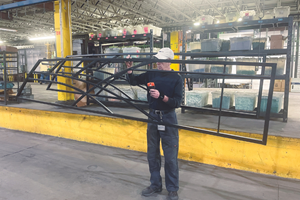Eliminating Pinholes
Question: We currently have a serious issue with a customer who we have been doing powder coating for the last seven years.
Question:
We currently have a serious issue with a customer who we have been doing powder coating for the last seven years. These parts are gray iron castings and have pinholes in the coating when viewed under a microscope. Our process has always been the same, but now the customer does not want any pinholes in the coating. We cannot preheat the parts without the film thickness getting too high, causing machining problems at our customer’s plant. We cannot fluidize bed coat the part for the same reasons. Our customer does not want us to coat the parts hot enough to melt and flow the powder coating material. The powder that we are using is epoxy. Would changing the powder material help? R. H.
Answer:
There are several things you can do. First of all, you don’t have to coat the parts hot to pre-outgas the parts before coating. The theory behind preheating a part to eliminate or reduce outgasing is based upon the fact that hot castings release the entrapped gasses often released during the curing of the powder coating. By preheating the part to 425°F for 15–30 minutes, it is assumed that all the entrapped gasses will be released prior to coating. You can, of course, allow the part to cool back to room temperature for coating purposes to control the film thickness without affecting the benefit of preheating the parts to release the entrapped gas.
The only problem with this methodology is that some castings have more entrapped gasses than is practical to release this way. You can pre-heat the part many times and still have an outgasing problem. This leads me to the next solution, improve the casting quality. Entrapped gasses can be reduced dramatically by improving the metal mixture (alloy), positioning casting vents and chills in key areas and slowing the casting pour time to allow more of the gas to escape before the metal hardens. These are all things that your customer can do to improve the situation, although they may not want to since it adds cost to the product.
The next thing you can try is another powder material that has outgasing benefits formulated into the powder. The powder supplier can formulate powders for coating castings that can go a long way to reducing or eliminating this annoying problem. The powder manufacturer can increase the time the powder coating is in a liquid state during cure to allow the entrapped gas to escape and then flow-over the pinholes before hardening during the final cure stages. Be careful, these powders are much easier to have runs or sags if applied too thick.
The powder coating manufacturer can also formulate powders that cure at a reduced temperature of around 250°F, which can be well below the temperature where the entrapped gasses are released from the casting. This may work for you, as well.
Finally, the pinholes can be caused by the powder coating formulation and not entrapped gasses, although this is very rare. Some curative agents in the powder coating can foam during high cure temperatures, causing pinholes in the coating surface. Check with your powder supplier to see if this is the case, but I doubt that they will admit it. Coat some test panels made from cold-rolled steel at the desired film thickness and cure temperature. If there are pinholes in the coating when examined under a microscope, then give your powder coating supplier a call. If not, then try the previously mentioned solutions.
Oh by the way, you may want to mention to your customer that microscopes are dangerous things, especially when they are used to examine powder coatings. They often cause the cost of their coating services to rise for no apparent reason and should only be used if there is a functional necessity for their product not to have any pinholes. I suspect that these pinholes have always been on their product, but could not be seen without the dangerous microscope inspection tool. That leads me to believe that they were happy with the look and performance of their powder coating for the last seven years, before they succumbed to the dark side of the dastardly microscope. Very few things in life can withstand examination under a microscope (i.e. tax returns, political statements, business ethics, accounting practices, character, etc.). It may be good to remind them of this.
Related Content
Powder Coating Overcomes Post Forming
Six Sigma methodology, open communication, and collaboration produce results for leading boat manufacturer.
Read MoreMasking Solutions Provider CFS Dramatically Expands Capabilities and Capacity
Custom Fabrication & Supplies (CFS) completed a new plant expansion packing 10 times the capacity into twice the space. It dramatically enhances the supplier’s custom capabilities to provide extremely precise and cost-effective masking solutions.
Read MoreLow-Temperature-Cure Powder Coatings Offer Unique Opportunities
An in-depth look at the advantages of low-temperature-cure powder coatings and the considerations for incorporating them into your process.
Read MoreCuring Oven Basics
Simply heating up the substrate does not cure the coating. There are many variables to consider when choosing the best cure oven for your application...
Read MoreRead Next
Education Bringing Cleaning to Machining
Debuting new speakers and cleaning technology content during this half-day workshop co-located with IMTS 2024.
Read MoreEpisode 45: An Interview with Chandler Mancuso, MacDermid Envio Solutions
Chandler Mancuso, technical director with MacDermid Envio discusses updating your wastewater treatment system and implementing materials recycling solutions to increase efficiencies, control costs and reduce environmental impact.
Read MoreA ‘Clean’ Agenda Offers Unique Presentations in Chicago
The 2024 Parts Cleaning Conference, co-located with the International Manufacturing Technology Show, includes presentations by several speakers who are new to the conference and topics that have not been covered in past editions of this event.
Read More

























